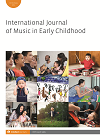
Full text loading...
This article outlines an action research/practitioner inquiry approach used in an ongoing professional development project involving educators in two early childhood (EC) education and care settings in Australia. The aim of this professional development project is to provide quality musical experiences for children as part of the overall curriculum, while at the same time building the musical knowledge, skills and confidence of the educators at the settings. The aim of the research is for the specialist music educator researchers to work collaboratively with the EC educators to develop an approach that will achieve the professional development aims. This article outlines the practitioner inquiry methodology used, and presents data and reflections on the most recent phases of the project, during which a focus on developing the musical attunement of educators to the children’s musicality and musical identities led to them sharing their own musical cultural identities with the children. Reflections from these phases of the project provide evidence of the positive impact of this approach on the musical self-efficacy of some educators, and the rich musical cultural sharing that has taken place.

Article metrics loading...

Full text loading...
References


Data & Media loading...

Publication Date:
https://doi.org/10.1386/ijmec.14.1.71_1 Published content will be available immediately after check-out or when it is released in case of a pre-order. Please make sure to be logged in to see all available purchase options.